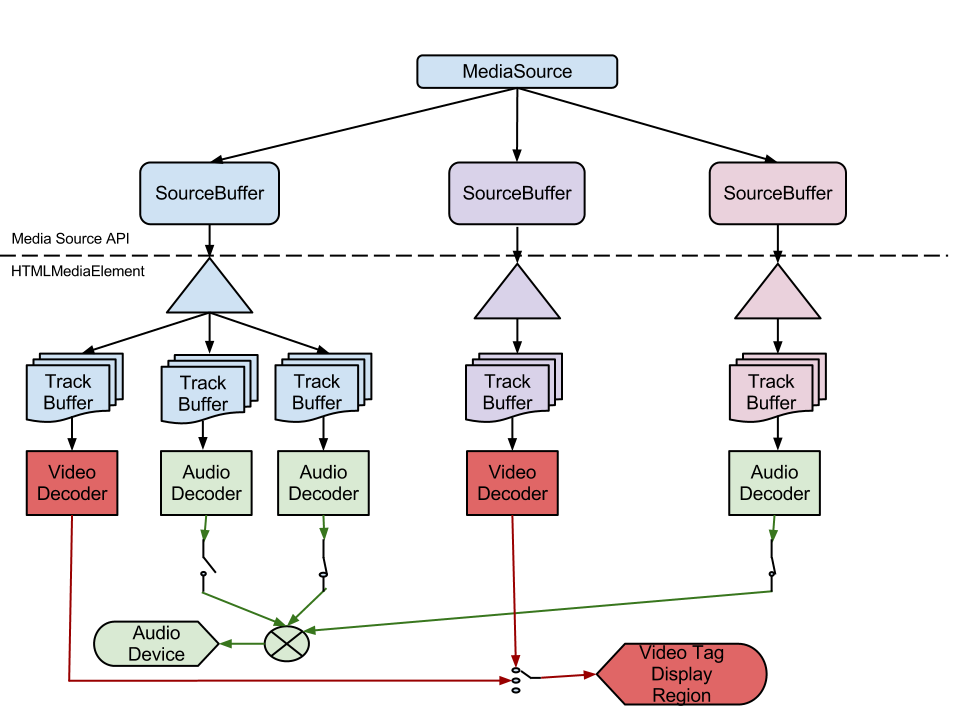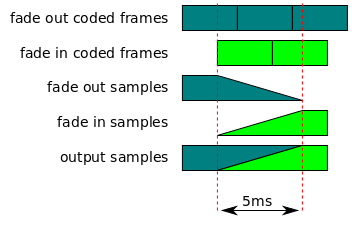| 01 June 2013 |
- Bug 21431 - Updated coded frame processing algorithm for text splicing.
- Bug 22035 - Update addtrack and removetrack event firing text to match HTML5 language.
- Bug 22111 - Remove useless playback sentence from end of stream algorithm.
- Bug 22052 - Add corrupted frame metric.
- Bug 22062 - Added links for filing bugs.
- Bug 22125 - Add "ended" to "open" transition to remove().
- Bug 22143 - Move HTMLMediaElement.playbackQuality to HTMLVideoElement.videoPlaybackQuality.
|
| 13 May 2013 |
- Bug 21954 - Add [EnforceRange] to appendStream's maxSize parameter.
- Bug 21953 - Add NaN handling to appendWindowEnd setter algorithm.
- Alphabetize definitions section.
- Changed endOfStream('decode') references to make it clear that JavaScript can't intercept these calls.
- Fix links for all types in the IDL that are defined in external specifications.
|
| 06 May 2013 |
- Bug 20901 - Remove AbortMode and add AppendMode.
- Bug 21911 - Change MediaPlaybackQuality.creationTime to DOMHighResTimeStamp.
|
| 02 May 2013 |
- Reworked ambiguous text in a variety of places.
- Added Acknowledgements section.
|
| 30 April 2013 |
- Bug 21822 - Fix 'fire ... event ... at the X attribute' text.
- Bug 21819 & 21328 - Remove 'compressed' from coded frame definition.
|
| 24 April 2013 |
- Bug 21796 - Removed issue box from 'Append Error' algorithm.
- Bug 21703 - Changed appendWindowEnd to 'unrestricted double'.
- Bug 20760 - Adding MediaPlaybackQuality object.
- Bug 21536 - Specify the origin of media data appended.
|
| 08 April 2013 |
- Bug 21327 - Crossfade clarifications.
- Bug 21334 - Clarified seeking behavoir.
- Bug 21326 - Add a note stating some implementations may choose to add fades to/from silence.
- Bug 21375 - Clarified decode dependency removal.
- Bug 21376 - Replace 100ms limit with 2x last frame duration limit.
|
| 26 March 2013 |
- Bug 21301 - Change timeline references to "media timeline" links.
- Bug 19676 - Clarified "fade out coded frames" definition.
- Bug 21276 - Convert a few append error scenarios to endOfStream('decode') errors.
- Bug 21376 - Changed 'time' to 'decode time' to append sequence definition.
- Bug 21374 - Clarify the abort() behavior.
- Bug 21373 - Clarified incremental parsing text in segment parser loop.
- Bug 21364 - Remove redundant condition from remove overlapped frame step.
- Bug 21327 - Clarify what to do with a splice that starts with an audio frame with a duration less than 5ms.
- Update to ReSpec 3.1.48
|
| 12 March 2013 |
- Bug 21112 - Add appendWindowStart & appendWindowEnd attributes.
- Bug 19676 - Clarify overlapped frame definitions and splice logic.
- Bug 21172 - Added coded frame removal and eviction algorithms.
|
| 05 March 2013 |
- Bug 21170 - Remove 'stream aborted' step from stream append loop algorithm.
- Bug 21171 - Added informative note about when addSourceBuffer() might throw an QUOTA_EXCEEDED_ERR exception.
- Bug 20901 - Add support for 'continuation' and 'timestampOffset' abort modes.
- Bug 21159 - Rename appendArrayBuffer to appendBuffer() and add ArrayBufferView overload.
- Bug 21198 - Remove redundant 'closed' readyState checks.
|
| 25 February 2013 |
- Remove Source Buffer Model section since all the behavior is covered by the algorithms now.
- Bug 20899 - Remove media segments must start with a random access point requirement.
- Bug 21065 - Update example code to use updating attribute instead of old appending attribute.
|
| 19 February 2013 |
- Bug 19676, 20327 - Provide more detail for audio & video splicing.
- Bug 20900 - Remove complete access unit constraint.
- Bug 20948 - Setting timestampOffset in 'ended' triggers a transition to 'open'
- Bug 20952 - Added update event.
- Bug 20953 - Move end of append event firing out of segment parser loop.
- Bug 21034 - Add steps to fire addtrack and removetrack events.
|
| 05 February 2013 |
- Bug 19676 - Added a note clarifying that the internal timestamp representation doesn't have to be a double.
- Added steps to the coded frame processing algorithm to remove old frames when new ones overlap them.
- Fix isTypeSupported() return type.
- Bug 18933 - Clarify what top-level boxes to ignore for ISO-BMFF.
- Bug 18400 - Add a check to avoid creating huge hidden gaps when out-of-order appends occur w/o calling abort().
|
| 31 January 2013 |
- Make remove() asynchronous.
- Added steps to various algorithms to throw an INVALID_STATE_ERR exception when async appends or remove() are pending.
|
| 30 January 2013 |
- Remove early abort step on 0-byte appends so the same events fire as a normal append with bytes.
- Added definition for 'enough data to ensure uninterrupted playback'.
- Updated buffered ranges algorithm to properly compute the ranges for Philip's example.
|
| 15 January 2013 |
Replace setTrackInfo() and getSourceBuffer() with AudioTrack, VideoTrack, and TextTrack extensions. |
| 04 January 2013 |
- Renamed append() to appendArrayBuffer() and made appending asynchronous.
- Added SourceBuffer.appendStream().
- Added SourceBuffer.setTrackInfo() methods.
- Added issue boxes to relevant sections for outstanding bugs.
|
| 14 December 2012 |
Pubrules, Link Checker, and Markup Validation fixes.
|
| 13 December 2012 |
- Added MPEG-2 Transport Stream section.
- Added text to require abort() for out-of-order appends.
- Renamed "track buffer" to "decoder buffer".
- Redefined "track buffer" to mean the per-track buffers that hold the SourceBuffer media data.
- Editorial fixes.
|
| 08 December 2012 |
- Added MediaSource.getSourceBuffer() methods.
- Section 2 cleanup.
|
| 06 December 2012 |
- append() now throws a QUOTA_EXCEEDED_ERR when the SourceBuffer is full.
- Added unique ID generation text to Initialization Segment Received algorithm.
- Remove 2.x subsections that are already covered by algorithm text.
- Rework byte stream format text so it doesn't imply that the MediaSource implementation must support all formats supported by the
HTMLMediaElement.
|
| 28 November 2012 |
- Added transition to HAVE_METADATA when current playback position is removed.
- Added remove() calls to duration change algorithm.
- Added MediaSource.isTypeSupported() method.
- Remove initialization segments are optional text.
|
| 09 November 2012 |
Converted document to ReSpec. |
| 18 October 2012 |
Refactored SourceBuffer.append() & added SourceBuffer.remove(). |
| 8 October 2012 |
- Defined what HTMLMediaElement.seekable and HTMLMediaElement.buffered should return.
- Updated seeking algorithm to run inside Step 10 of the HTMLMediaElement seeking algorithm.
- Removed transition from "ended" to "open" in the seeking algorithm.
- Clarified all the event targets.
|
| 1 October 2012 |
Fixed various addsourcebuffer & removesourcebuffer bugs and allow append() in ended state. |
| 13 September 2012 |
Updated endOfStream() behavior to change based on the value of HTMLMediaElement.readyState. |
| 24 August 2012 |
- Added early abort on to duration change algorithm.
- Added createObjectURL() IDL & algorithm.
- Added Track ID & Track description definitions.
- Rewrote start overlap for audio frames text.
- Removed rendering silence requirement from section 2.5.
|
| 22 August 2012 |
- Clarified WebM byte stream requirements.
- Clarified SourceBuffer.buffered return value.
- Clarified addsourcebuffer & removesourcebuffer event targets.
- Clarified when media source attaches to the HTMLMediaElement.
- Introduced duration change algorithm and update relevant algorithms to use it.
|
| 17 August 2012 |
Minor editorial fixes. |
| 09 August 2012 |
Change presentation start time to always be 0 instead of using format specific rules about the first media segment appended. |
| 30 July 2012 |
Added SourceBuffer.timestampOffset and MediaSource.duration. |
| 17 July 2012 |
Replaced SourceBufferList.remove() with MediaSource.removeSourceBuffer(). |
| 02 July 2012 |
Converted to the object-oriented API |
| 26 June 2012 |
Converted to Editor's draft. |
| 0.5 |
Minor updates before proposing to W3C HTML-WG. |
| 0.4 |
Major revision. Adding source IDs, defining buffer model, and clarifying byte stream formats. |
| 0.3 |
Minor text updates. |
| 0.2 |
Updates to reflect initial WebKit implementation. |
| 0.1 |
Initial Proposal |

